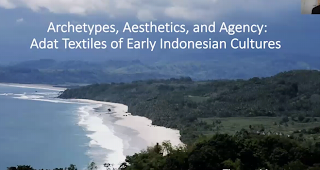Yesterday was a presentation, made world-wide, by collector Thomas Murray, two separate zoom casts, one for each half of the planet, more or less, on Indonesian textiles.
These far predate the batiks we usually think of from that part of the world, many from the fifteenth and sixteenth centuries.
The designs feature boats a lot, given their island culture, and their looms are largely back strap, very portable. In one picture you also see a researcher demonstrating the supported spindle, which I liked a lot.
Some of the fibers predate the availability of cotton, using bast and bark and silk. Mostly these are ceremonial items, hence the preservation. And there's beadwork for bead fans. He paid tribute to the women artists, since this is largely the work of women.
He spent a lot of time on carbon dating, which I sort of skipped by, being more interested in the art and culture than scientific proofs of age.
Anyway, just browse, enjoy. The word adat in the title refers to the rules of life as reflected in textiles and other artworks.
I selected only a few of the hundreds of images flying by and tried to crop out the captioning where I could. But you get the gist.
A lot of the researchers are from the Netherlands, since they were the colonial invaders of Indonesia, largely in search of spices, valuable commodities.
I live in hopes that a lot of these wealthy white men's collections will be restored to the culture they were plundered from.
It's fine to honor the history by this kind of presentation, and better still to give the textiles and bead artworks back.
Meanwhile, I'm tending to my little corner, stitching, knitting, trying to organize the patio a bit, but most of the outdoor work takes more strength than I have available.
Never forget Ukraine
Photo by AC












































I find it a glory that almost all cultures have developed weaving in one form or another and that so many have made what probably started as a pragmatic way to create needed items into art.
ReplyDeleteI support repatriation of colonized peoples' arts and crafts too.
ReplyDeleteThis is definitely something I've never really considered -- Indonesian weaving -- but it's quite interesting. As Ms. Moon said, the commonality of weaving across cultures is intriguing.
ReplyDeleteEach textile item makes me want to know about it - how it came to be, how it was intended to be used, and what its place was in the culture.
ReplyDeleteYes, send the contents of museums back to the land of origin and fill the space with local work.
ReplyDeleteI suppose there's two schools of thought, one being sending the items back to their origin but also there's the fact that how else will other countries learn about them without having to travel. Hard to know what to do in this case, and the same can be said about animals being kept in zoos.
ReplyDeleteThe thing is that most of these textiles are in private collections. So they're not available to learn from. It's only when the collector writes a book and does pr or wants to sell, that we get these chances.
ReplyDelete